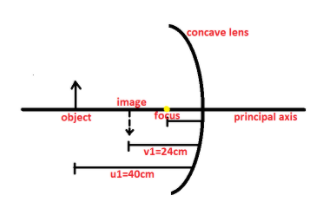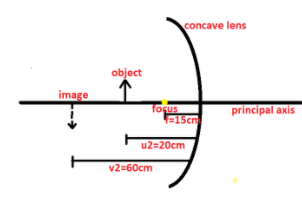
An object is placed at a distance of \[40{{ }}cm\] from a concave mirror of focal length \[15{{ }}cm\]. If the object is displaced through a distance of \[20{{ }}cm\] towards the mirror, the displacement of the image will be:
A. \[30{{ }}cm\] towards the mirror
B. \[30{{ }}cm\] away from the mirror
C. \[36{{ }}cm\]towards the mirror
D. \[36{{ }}cm\] away from the mirror
Answer
553.8k+ views
Hint: Using the relationship between image, focal and object distance we will determine the image distance in case of both the object positions. Subtracting them will give us our displacement of the image.
Formula Used: Relationship between image, focal and object distance: $\dfrac{1}{v} = \dfrac{1}{u} + \dfrac{1}{f}$
Where \[v,u,f\] are the image, focal and object distances from the length and are measured in centimeters $(cm)$.
Complete step by step answer:We have two conditions given in our question. Therefore, we will solve this question in a three step process: determine first image distance, determine second object distance, determine difference between the both.
We have the following given data:
We have a concave mirror.
Focal length is give as \[15{{ }}cm\]. That means \[f = - 15cm\]. It is negative as it is on the left hand side of the lens.
Condition 1: Object distance is \[40{{ }}cm\] from concave mirror $ = {u_1} = - 40cm$. It is negative as it is on the left hand side of the lens.
Condition 2: Object distance is \[20{{ }}cm\] towards the mirror $ = {u_2} = - 40 + 20 = - 20cm$. It is negative as it is on the left hand side of the lens.
Let’s say in the two conditions, the image distances are ${v_1},{v_2}cm$.
According to the image we get the following value of image distance by substituting the values,
$
\dfrac{1}{{{v_1}}} = \dfrac{1}{{{u_1}}} + \dfrac{1}{f} = - \dfrac{1}{{40}} - \dfrac{1}{{15}} \\
\Rightarrow \dfrac{1}{{{v_1}}} = - \dfrac{1}{{24}} \\
\Rightarrow {v_1} = - 24cm \\
$
Image is $24cm$ away from the lens.

And for condition two we get,
$
\dfrac{1}{{{v_2}}} = \dfrac{1}{{{u_2}}} + \dfrac{1}{f} = - \dfrac{1}{{20}} - \dfrac{1}{{15}} \\
\Rightarrow \dfrac{1}{{{v_2}}} = - \dfrac{1}{{60}} \\
\Rightarrow {v_2} = - 60cm \\
$
Image is $60cm$ away from the lens.

Therefore, the displacement of the image due to displacement of the object is $ - 24 - ( - 60) = 60 - 24 = 36cm$ away from the mirror.
In conclusion, the correct option is D.
Note:the sign of the image, object and focal distances are to be very carefully noted.it is always negative if it is on the left hand side of the lens and positive if it is on the right hand side.
Formula Used: Relationship between image, focal and object distance: $\dfrac{1}{v} = \dfrac{1}{u} + \dfrac{1}{f}$
Where \[v,u,f\] are the image, focal and object distances from the length and are measured in centimeters $(cm)$.
Complete step by step answer:We have two conditions given in our question. Therefore, we will solve this question in a three step process: determine first image distance, determine second object distance, determine difference between the both.
We have the following given data:
We have a concave mirror.
Focal length is give as \[15{{ }}cm\]. That means \[f = - 15cm\]. It is negative as it is on the left hand side of the lens.
Condition 1: Object distance is \[40{{ }}cm\] from concave mirror $ = {u_1} = - 40cm$. It is negative as it is on the left hand side of the lens.
Condition 2: Object distance is \[20{{ }}cm\] towards the mirror $ = {u_2} = - 40 + 20 = - 20cm$. It is negative as it is on the left hand side of the lens.
Let’s say in the two conditions, the image distances are ${v_1},{v_2}cm$.
According to the image we get the following value of image distance by substituting the values,
$
\dfrac{1}{{{v_1}}} = \dfrac{1}{{{u_1}}} + \dfrac{1}{f} = - \dfrac{1}{{40}} - \dfrac{1}{{15}} \\
\Rightarrow \dfrac{1}{{{v_1}}} = - \dfrac{1}{{24}} \\
\Rightarrow {v_1} = - 24cm \\
$
Image is $24cm$ away from the lens.

And for condition two we get,
$
\dfrac{1}{{{v_2}}} = \dfrac{1}{{{u_2}}} + \dfrac{1}{f} = - \dfrac{1}{{20}} - \dfrac{1}{{15}} \\
\Rightarrow \dfrac{1}{{{v_2}}} = - \dfrac{1}{{60}} \\
\Rightarrow {v_2} = - 60cm \\
$
Image is $60cm$ away from the lens.

Therefore, the displacement of the image due to displacement of the object is $ - 24 - ( - 60) = 60 - 24 = 36cm$ away from the mirror.
In conclusion, the correct option is D.
Note:the sign of the image, object and focal distances are to be very carefully noted.it is always negative if it is on the left hand side of the lens and positive if it is on the right hand side.
Recently Updated Pages
Master Class 12 Economics: Engaging Questions & Answers for Success

Master Class 12 Maths: Engaging Questions & Answers for Success

Master Class 12 Biology: Engaging Questions & Answers for Success

Master Class 12 Physics: Engaging Questions & Answers for Success

Basicity of sulphurous acid and sulphuric acid are

Master Class 12 Business Studies: Engaging Questions & Answers for Success

Trending doubts
What are the major means of transport Explain each class 12 social science CBSE

Which are the Top 10 Largest Countries of the World?

Draw a labelled sketch of the human eye class 12 physics CBSE

How much time does it take to bleed after eating p class 12 biology CBSE

Explain sex determination in humans with line diag class 12 biology CBSE

Differentiate between homogeneous and heterogeneous class 12 chemistry CBSE




